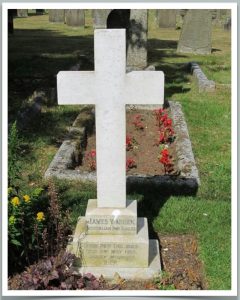5th Battalion, Australian Pioneers

James Warren was born, at sea, on 26 December 1883 and was the son of John James Truro and Rose Warren.
His father died prior to 1910 and his mother re-married to become Mrs Torrance, who lived at 720 Beaufort Street, Mount Lawley, Perth, Western Australia.
On his enlistment papers James noted that he had been an apprentice at Western Australia Railway and his occupation was an engineer. He also noted his previous service of five years with the ‘Western Australian Infantry’. This could have been the Western Australian Mounted Infantry, which fought in the Boer War but he would not have been old enough then.
One source states that James had been a scholar at Freemantle State School.
Surprisingly given his Western Australian connections, James Warren enlisted at Randwick in New South Wales on 27 August 1914. He was 30 years and six months old and unmarried.
He was posted to ‘H’ Company of the 2nd Battalion, Australian Infantry.
He embarked from Sydney on the HMTS Suffolk on 18 October 1914 and the initial destination was England. However with British Empire forces in action in Egypt defending the Suez Canal from Turkish forces, this was changed to Egypt, where disembarkation took place on 2 December 1914.
In the event the 2nd Battalion (part of 1 Brigade, 1 Australian Division) saw little action in Egypt.
They did however see action at Gallipoli, being part of the second and third wave of landings at Anzac Beach on 25 April 1915. However, it is not known if Private Warren was part of this landing, as his service record gives his arrival at Gallipoli as being on 7 May 1915. On 19 May he was posted to Divisional HQ at Anzac but ten days later he was struck down with gastro-enteritis and moved through No 3 Field Ambulance and 1st Australian Casualty Clearing Station before being shipped to the island base of Mudros.
From here he was sent on 2 September, on board the Hospital Ship Huntsend to Malta, arriving on 6 September. By 19 September he was in England, having been admitted to 1st Southern General Hospital, Birmingham.
Following his recovery from illness Private Warren reported to the Australian Infantry depot in London and on 25 March 1916 left with a draft of men bound for Egypt, on board the troopship Huntshill.
His ship arrived in Alexandria on 5 April and on 16 April he joined the 1st Training Battalion at Tel-el-Kebir. On the 24th of that month he was posted to Ismailia, to join up with the 5th Battalion, Australian Pioneers.
On 19 June 1916 he sailed with the troopship Canada from Alexandria to Marseilles and he arrived on 25 June. From there it was a long train journey north to the Western Front.
On 10 October 1916 Private Warren was sent on detached duty to 1st Army Forest Control and he was admitted to the 1st New Zealand Stationery Hospital at Amiens on 22 January 1917 with a head wound (cause unknown).
On the 27th he was released back to the 5th Battalion Pioneers but must then have gone on detachment once more to the 4th Army, as on 26 June 1917 he was found guilty of being drunk and disorderly at one of their saw mills and forfeited 21 days pay: the only disciplinary blemish on his army career.
Two days later he was back with the 5th Battalion Pioneers and then from 27 September to 10 October 1917 he was on UK leave.
In mid-April 1918 the 5th Battalion Pioneers were engaged on digging defensive works between Amiens and Villers-Bretonneux, as part of attempts to slow or halt the German advance, which was part of their Spring Offensive.
On the night of the 17th the area was subjected to attack by mustard gas and Private Warren was one of a number of men affected. He passed through 2nd Casualty Clearing Station and was put on an ambulance train to 11th Stationery Hospital at Rouen, where he was admitted on 19 April.
Badly affected by the gas he was sent back to England on the Hospital Ship Grantully Castle on 21 April and admitted to Suffolk Hall VAD Hospital, in Lypiatt Road Cheltenham, on the following day.
Here he was looked after by staff of the No 26 Gloucestershire Voluntary Aid Detachment. On 24 April his temperature rose over four degrees above normal (Fahrenheit), put down to an attack of influenza, which had afflicted all the inmates of his ward.
From 26 April onwards he was afflicted by breathing difficulties and died at 3.30pm on 2 May 1918, aged 33.
The cause of death was officially bronchial pneumonia and influenza, though undoubtedly the damage cause to his lungs by the gas played a significant part.
A full military funeral was held for him on 4 May 1918, at 2pm, when he was interred at Cheltenham Cemetery. The Gloucestershire Volunteer Regiment provided the usual band, bugler and firing party and about 200 patients and staff from the hospital attended.
Originally a wooden cross marked the grave but in time this was replaced by a white marble stone cross, on which was inscribed Deeply mourned RIP: Australian Imperial Forces.
Unusually a standard CWGC headstone was not placed, presumably the wish of his family.
Research by Graham Adams 5 March 2013
